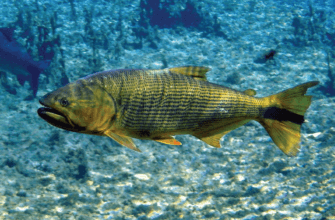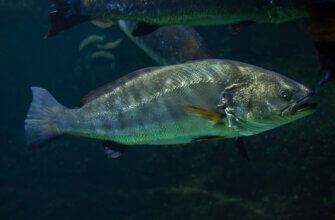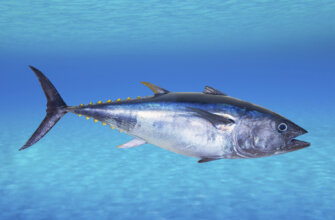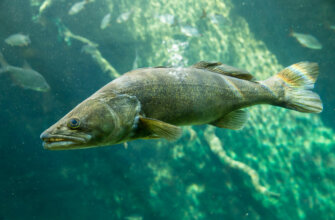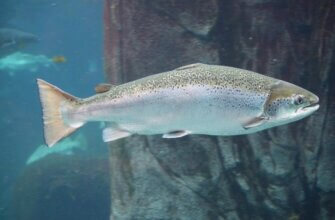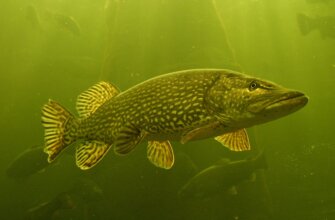Bass fish, also known simply as bass, are a group of freshwater fish belonging to the family Centrarchidae. They are popular among anglers and are highly sought after for sport fishing due to their fighting ability and size.
Bass are predatory fish and feed on a variety of prey, including smaller fish, crayfish, insects, and even small mammals or birds that happen to fall into the water. They have excellent vision and rely on ambush tactics to capture their prey.
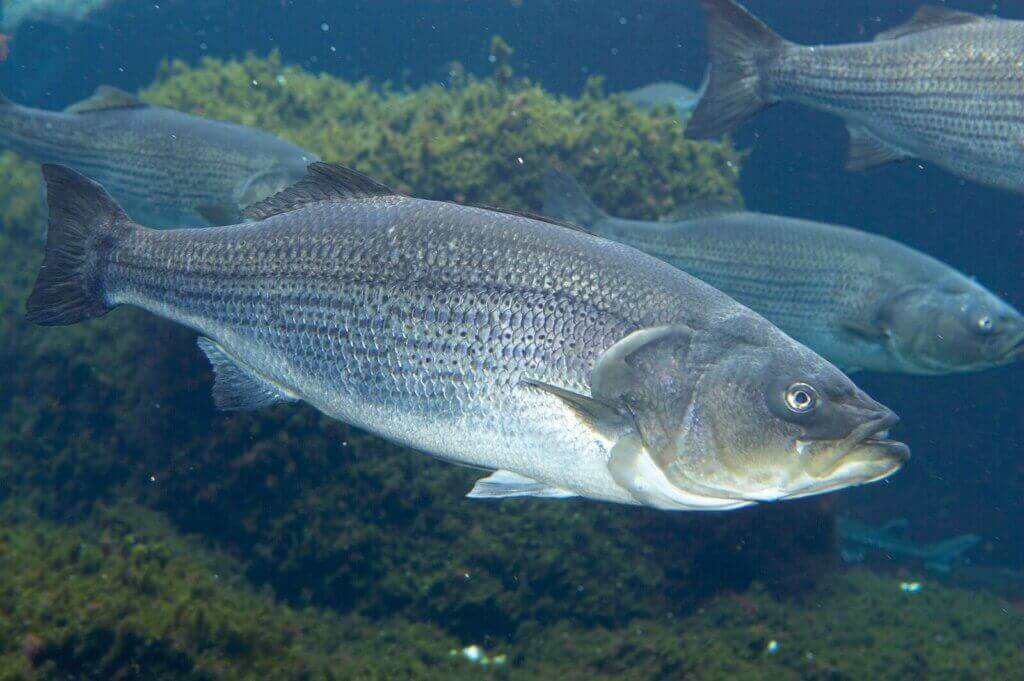
When it comes to fishing for bass, different techniques and lures are used depending on the species and the fishing conditions. Common methods include casting artificial lures, such as crankbaits, soft plastics, and topwater baits, as well as using live bait like minnows or worms. Anglers often target bass near structures like submerged logs, weed beds, and rocky areas where bass tend to hide and search for food.
It’s important to note that fishing regulations and seasons can vary depending on the location, so it’s always a good idea to check local fishing regulations before heading out to fish for bass. Additionally, practicing catch-and-release fishing can help preserve the bass population and ensure their sustainability for future generations of anglers.
Species
There are several species of bass, each with its own characteristics and distribution. Here are some of the most well-known bass species:
- Largemouth Bass (Micropterus salmoides): Largemouth bass are one of the most popular freshwater game fish in North America. They are known for their large mouths and are found in lakes, reservoirs, ponds, and slow-moving rivers across the United States and parts of Canada. Largemouth bass can grow to impressive sizes and are prized by anglers for their aggressive strikes and fighting ability.
- Smallmouth Bass (Micropterus dolomieu): Smallmouth bass, also called “smallies,” are another highly sought-after game fish. They have a more streamlined body compared to largemouth bass and are known for their bronze color and vertical black bands on their sides. Smallmouth bass prefer clear, cool rivers, streams, and lakes and are found throughout North America.
- Spotted Bass (Micropterus punctulatus): Spotted bass are similar in appearance to largemouth bass, but they have a distinctive pattern of dark spots along their sides. They are native to the central and eastern United States and are often found in rivers and reservoirs. Spotted bass exhibit characteristics of both largemouth and smallmouth bass, and they can provide a thrilling fishing experience.
- Striped Bass (Morone saxatilis): Striped bass, also known as stripers, are a migratory saltwater species that can also be found in freshwater environments. They have a silvery body with distinctive dark stripes running along their sides. Striped bass are known for their size and strength and are targeted by anglers in coastal areas and large rivers.
- White Bass (Morone chrysops): White bass are closely related to striped bass and have a similar appearance but with a more silver coloration. They are found in rivers and reservoirs in North America and are known for their schooling behavior, making them an exciting species to target for anglers.
These are just a few examples of bass species, and there are other regional and lesser-known species as well. Each species has its own unique characteristics, habitats, and fishing techniques associated with it.
Appearance
Bass have a distinct appearance that varies slightly between different species. Here are some general characteristics of bass:
- Body Shape. Bass have a streamlined body shape that is well-suited for their predatory nature. They have a somewhat elongated, muscular body with a broad, deep, and laterally compressed profile. This body shape allows them to move swiftly through the water and ambush their prey.
- Mouth. Bass are known for their large mouths, which are equipped with a strong jaw and sharp teeth. The size of the mouth varies depending on the species, with largemouth bass having particularly large mouths compared to other bass species.
- Fins. Bass have a dorsal fin located on their back, as well as an anal fin on their underside. The dorsal fin is typically divided into two sections, with the anterior section having spines and the posterior section being made up of soft rays. The anal fin is also composed of soft rays.
- Coloration. The coloration of bass can vary depending on the species, habitat, and environmental conditions. Largemouth bass often have a dark greenish to olive-colored back with lighter sides that may transition to a whitish belly. They may also exhibit dark horizontal bands or blotches along their sides. Smallmouth bass tend to have a bronze or brownish coloration with vertical dark bands on their sides. Spotted bass have a similar appearance to largemouth bass but with distinct dark spots along their sides.
- Scales. Bass have cycloid scales, which are smooth to the touch and have a rounded shape. These scales provide some protection to the fish and contribute to their sleek appearance.
It’s important to note that the appearance of bass can vary within species, influenced by factors such as age, diet, and environmental conditions. Additionally, individual variation and hybridization between species can further contribute to differences in appearance among bass populations.
Size and weight
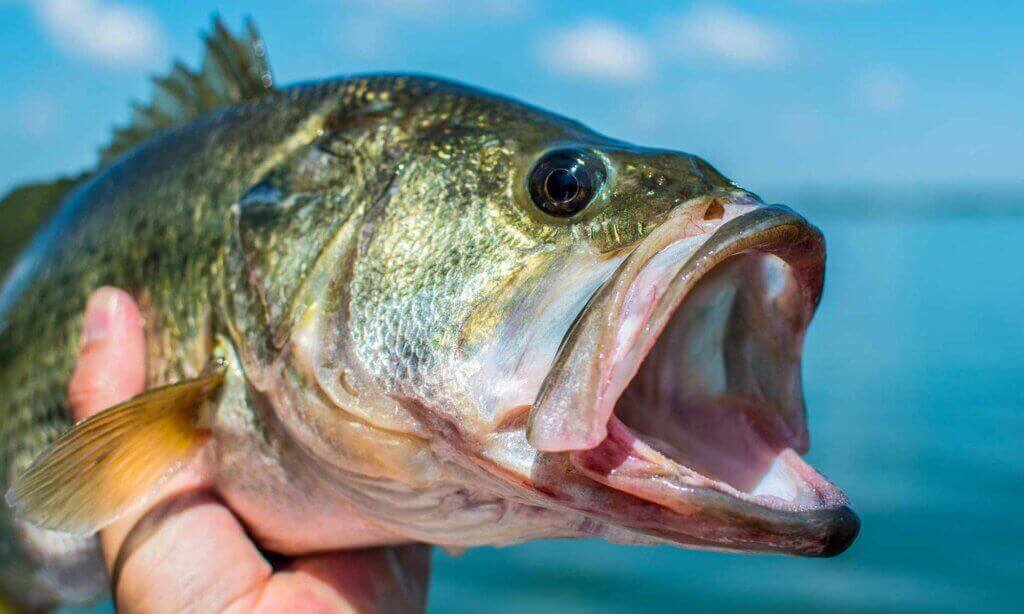
The size and weight of bass fish can vary greatly depending on the species, age, and location. The largemouth bass, one of the most popular species, can range from 12 to 24 inches in length and can weigh anywhere from 1 to 10 pounds. The smallmouth bass, another common species, is typically smaller, ranging from 8 to 20 inches in length and weighing between 1 and 5 pounds. The world record for the largest largemouth bass caught weighed in at 22 pounds, 4 ounces, while the largest smallmouth bass caught weighed 11 pounds, 15 ounces.
Diet
If you’re referring to the diet of bass fish, they are primarily carnivorous and feed on a variety of prey items. The specific diet of a bass can vary depending on its habitat, size, and available food sources.
Here are some common food sources for bass:
- Fish. Bass are opportunistic predators and often feed on other fish. They may target smaller fish species such as minnows, shad, sunfish, and perch. They use their sharp teeth and strong jaws to capture and consume their prey.
- Crustaceans. Bass also eat crustaceans like crayfish and shrimp. These provide a good source of protein and are often found in freshwater habitats where bass reside.
- Insects. Bass will consume various insects, including grasshoppers, dragonflies, mayflies, and beetles. Insects are abundant in aquatic environments and can be an important part of a bass’s diet, especially during certain seasons.
- Amphibians. Bass are known to feed on amphibians such as frogs and tadpoles. They are skilled at ambushing and capturing these prey items near the water’s edge or in shallow areas.
- Small mammals and birds. In rare cases, large bass may prey on small mammals like mice or birds that are near the water. However, such instances are not a significant part of their overall diet.
It’s important to note that the diet of bass can vary depending on their age, location, and specific environmental factors. They are highly adaptable predators and will consume whatever prey is available and suitable for their size and habitat.
Behavior
Bass fish, particularly popular species like largemouth bass and smallmouth bass, exhibit various behaviors that are interesting to observe and study.
Here are some common behaviors displayed by bass fish:
- Ambush Predation. Bass are ambush predators, meaning they prefer to lie in wait for their prey and strike suddenly. They use their excellent camouflage and stealthy movements to hide among aquatic vegetation, structure like rocks or fallen trees, or in shadows. When an unsuspecting prey item swims by, the bass will quickly lunge forward to capture it.
- Feeding Patterns. Bass are known to be crepuscular feeders, meaning they are most active during dawn and dusk when light conditions are low. However, they can also feed throughout the day, especially in cloudy or overcast conditions. During feeding, bass may exhibit aggressive behavior, chasing and attacking their prey.
- Territory and Spawning Behavior. Bass are territorial fish, particularly during the spawning season. Male bass build nests in shallow water, typically near submerged vegetation or structure, and defend these territories from other fish, including other males. They exhibit aggressive behaviors, such as chasing away intruders or engaging in confrontations with rival males.
- Nest Guarding. After the female lays her eggs in the nest, the male bass assumes the role of guarding and protecting the eggs. The male fiercely defends the nest from potential threats, such as other fish or predators, until the eggs hatch and the fry disperse.
- Structure-oriented Behavior. Bass are often associated with underwater structure, such as submerged logs, rocks, or vegetation. They use these structures as hiding places and ambush points to launch attacks on prey. They may also seek shelter in these structures to protect themselves from strong currents or adverse weather conditions.
- Seasonal Movement. Bass exhibit seasonal movement patterns, seeking out different habitats based on changing environmental conditions. In colder months, they tend to move to deeper water or seek areas with more stable water temperatures. In warmer months, they may move to shallower areas with abundant food and suitable spawning conditions.
These behaviors can vary depending on factors like species, size, location, and environmental conditions. Observing bass in their natural habitat can provide valuable insights into their behavior and interactions within the ecosystem.
Spawning
Spawning is a critical phase in the reproductive cycle of bass fish. During this time, bass engage in specific behaviors related to courtship, nest building, egg fertilization, and guarding the nest.
Let’s explore the spawning process of bass:
- Seasonal Timing. Bass spawning typically occurs in the spring when water temperatures reach the optimal range for reproduction. The timing can vary depending on the species and geographical location. Largemouth bass tend to spawn when water temperatures range from 60 to 75 degrees Fahrenheit (15 to 24 degrees Celsius), while smallmouth bass prefer slightly cooler temperatures.
- Courtship and Pairing. Bass engage in courtship rituals to attract mates. Male bass create nests by clearing debris, vegetation, or sediment from the bottom of the water. They use their tails to fan the area, creating a circular depression. Male bass then court female bass by swimming around them, vibrating their bodies, and occasionally nudging or bumping them.
- Egg-Laying. Once courtship is successful, the female bass lays her eggs within the nest. She releases thousands of eggs, which are adhesive and stick to the substrate, such as rocks, vegetation, or the nest created by the male. The female may lay eggs in multiple nests created by different males.
- Fertilization. As the female deposits her eggs, the male follows closely behind, releasing sperm to fertilize them. The male bass ensures thorough coverage of the eggs with sperm to increase the chances of successful fertilization.
- Nest Guarding. After the eggs are fertilized, the male assumes the responsibility of nest guarding. He aggressively defends the nest against intruders, including other fish. The male remains close to the nest, fanning the eggs with his fins to provide oxygenated water for proper development. He may also use his body to create a protective barrier over the nest.
- Hatching and Fry Care. The eggs typically hatch within a few days, depending on water temperature. The newly hatched fry (baby bass) stay close to the nest and the male for some time. The male continues to guard and protect the fry until they are strong enough to swim and fend for themselves. Once the fry disperse, the male may abandon the nest and resume normal feeding behavior.
It’s important to note that while this general process applies to many bass species, there can be variations in behavior and specific spawning requirements based on factors like location, habitat, and individual variations.
Fishing
Fishing for bass is a popular recreational activity enjoyed by many anglers. Bass fishing can be done in freshwater bodies such as lakes, rivers, ponds, and reservoirs.
Here are some tips and techniques for fishing bass:
- Equipment. Choose appropriate fishing gear for bass fishing. A medium to heavy-action fishing rod with a reel that matches the line weight is recommended. Spinning or baitcasting reels are commonly used. Use fishing line with sufficient strength, usually in the range of 10 to 20-pound test, depending on the size of bass you’re targeting.
- Lures and Baits. Bass are known to be aggressive and opportunistic feeders, so a variety of lures and baits can be effective. Popular choices include plastic worms, crankbaits, jigs, spinnerbaits, topwater lures, and swimbaits. Experiment with different colors, sizes, and styles to see what the bass are responding to on a given day.
- Location and Structure. Bass are often found near underwater structures such as rocks, fallen trees, submerged vegetation, and drop-offs. Look for areas with cover and ambush points where bass can hide and wait for their prey. Pay attention to points, ledges, and areas with a change in depth, as they can attract bass.
- Time of Day. Bass fishing can be productive at different times of the day. Early morning and late evening, during dawn and dusk, are often considered prime times as bass are more active. However, bass can be caught throughout the day, especially in overcast or low-light conditions. Adapt your fishing strategies based on the conditions and the behavior of the bass.
- Presentation Techniques. Experiment with various presentation techniques to entice bass to bite. This can include casting lures near structure, slow and steady retrieves, stop-and-go retrieves, or using techniques like jigging or flipping. Vary the speed, depth, and action of your lures to find what triggers a response from the bass.
- Practice Catch and Release. Bass are often released after being caught to ensure sustainable fishing practices and conservation of the bass population. Handle the fish gently, wet your hands before handling them to protect their slime coat, and release them back into the water promptly.
- Stay Informed. Stay updated on local fishing regulations, including catch limits, size restrictions, and any specific rules for bass fishing in your area. It’s important to respect these regulations to help preserve bass populations and ensure the long-term sustainability of the sport.
Remember that fishing can be influenced by factors such as weather, water conditions, and the specific habits of the bass in your area. Patience, observation, and adaptability are key to becoming a successful bass angler.
Lures
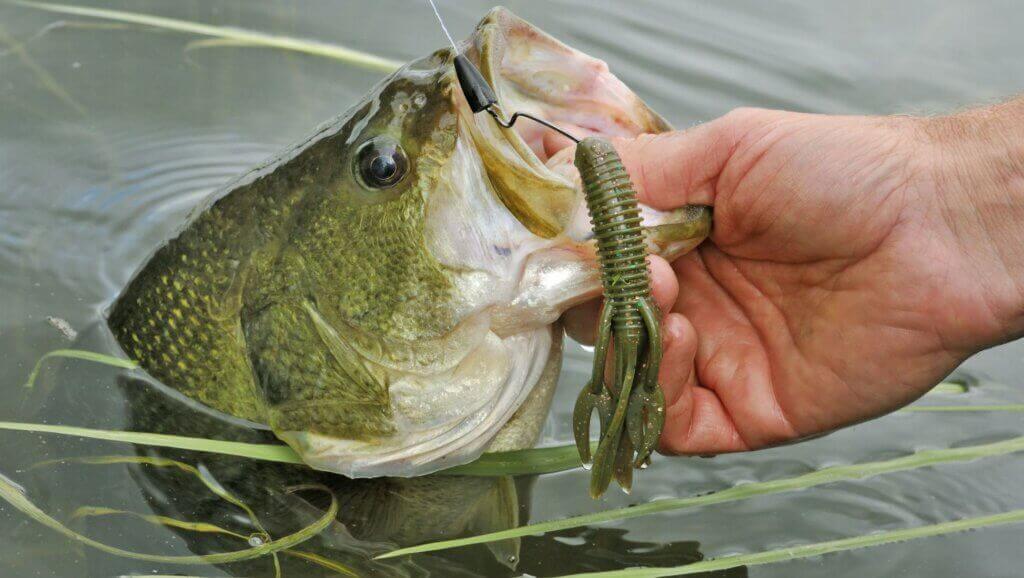
Here are some common types of lures used for bass fishing, along with a brief description of each:
- Plastic Worms. Plastic worms are versatile and effective lures for bass fishing. They come in various lengths, colors, and styles, including straight-tail worms, curly-tail worms, and creature baits. Rig them on a worm hook, Texas rig, Carolina rig, or wacky rig for different presentations.
- Crankbaits. Crankbaits are hard-bodied lures that mimic the movement of baitfish. They have a diving lip that allows them to dive to specific depths when retrieved. Crankbaits come in different sizes, shapes, and diving depths, allowing you to target various depths of the water column.
- Jigs. Jigs consist of a weighted head and a skirt made of silicone or rubber strands. They are versatile lures that can be used in various fishing techniques, such as flipping, pitching, and swimming. Jigs can be paired with soft plastic trailers to enhance their appeal.
- Spinnerbaits. Spinnerbaits are lures with a metal blade or blades that spin around a wire frame. They create flash and vibration in the water, attracting bass. Spinnerbaits typically have a skirt and one or more blades. They can be retrieved at various speeds and are effective in covering water quickly.
- Topwater Lures. Topwater lures are designed to imitate prey that floats or moves on the water’s surface. They include poppers, walking baits, buzzbaits, and frogs. Topwater lures create commotion and sound, often triggering aggressive strikes from bass.
- Swimbaits. Swimbaits are lifelike lures that mimic baitfish. They are typically made of soft plastic or hard plastic and come in different sizes and styles. Swimbaits can be retrieved steadily or with a more erratic action, imitating a wounded or fleeing fish.
- Soft Plastic Creature Baits. Creature baits are soft plastic lures designed to mimic creatures such as crawfish, lizards, or insects. They have unique shapes, appendages, and textures that create lifelike movements in the water. Creature baits are often used in flipping, pitching, or Texas rig presentations.
- Jerkbaits. Jerkbaits are long, slender lures with a suspending or floating action. They imitate injured or dying baitfish and are worked with sharp, twitching movements. Jerkbaits can be effective in cold-water conditions or when bass are feeding on smaller baitfish.
These are just a few examples of the wide variety of lures available for bass fishing. Each type of lure has its own unique action, presentation style, and fishing technique. Experimenting with different lures and techniques can help you determine what works best in different fishing situations and for the behavior of bass in your area.
Here are some specific examples of fishing lures for bass, along with their models and specifications:
- Plastic Worms:
- Model: Zoom Bait Magnum Trick Worm.
- Size: 7 inches.
- Style: Straight-tail worm.
- Color: Watermelon Seed.
- Rigging: Texas rig or Carolina rig.
- Crankbaits:
- Model: Rapala Shad Rap.
- Size: SR7 (2.75 inches).
- Diving Depth: 7 to 15 feet.
- Color: Shad or Crawdad.
- Retrieve: Steady retrieve or stop-and-go retrieve.
- Jigs:
- Model: Strike King Tour Grade Football Jig.
- Weight: 3/8 ounce.
- Color: Green Pumpkin.
- Skirt Material: Silicone.
- Trailer: Green Pumpkin Craw Chunk.
- Spinnerbaits:
- Model: Booyah Pond Magic Spinnerbait.
- Size: 1/8 ounce.
- Color: White Chartreuse.
- Blade Configuration: Willow blade.
- Retrieve: Steady retrieve or slow-rolling.
- Topwater Lures:
- Model: Heddon Super Spook Jr.
- Size: 3.5 inches.
- Color: Bone or Baby Bass.
- Action: Walk-the-dog.
- Retrieve: Twitching with short pauses.
- Swimbaits:
- Model: Keitech Swing Impact FAT.
- Size: 3.8 inches.
- Color: Ayu or Bluegill Flash.
- Action: Paddle tail.
- Rigging: Weighted swimbait hook or jighead.
- Soft Plastic Creature Baits:
- Model: Zoom Brush Hog.
- Size: 4.25 inches.
- Color: Green Pumpkin.
- Appendages: Multiple flapping appendages.
- Rigging: Texas rig or flipping rig.
- Jerkbaits:
- Model: Megabass Vision 110.
- Size: 4.33 inches.
- Suspends at: 4 to 6 feet.
- Color: Mat Tiger or Pro Blue.
- Action: Suspending, twitching, and darting motion.
Please note that the models and specifications mentioned are just examples, and there are many other brands, models, and variations available in the market. It’s essential to choose lures based on the specific fishing conditions, preferences, and the behavior of the bass in your area.
Baits
Here are some specific examples of baits for bass fishing, along with additional details about each:
- Live Baits:
- Shad: Shad are a natural food source for bass. Use live shad as bait by hooking them through the lips or dorsal fin.
- Minnows: Minnows, such as shiners or fathead minnows, are effective live baits for bass. Hook them through the lips or back to present a natural presentation.
- Crawfish:
- Crayfish: Crawfish are a preferred meal for bass. Use live or fresh dead crayfish, hooked through the tail or head, to mimic their natural movement.
- Frogs:
- Soft Plastic Frogs: Soft plastic frog lures with hollow bodies are designed to float on the water’s surface. Retrieve them with a walking or hopping action to imitate a frog’s movement.
- Insects:
- Grasshoppers and Crickets: These natural insects can be used as live baits for bass. Hook them through the thorax or collar and present them on the water’s surface or just below.
- Artificial Baits:
- Spinnerbaits: Spinnerbaits are effective artificial baits that feature metal blades, skirts, and a hook. Retrieve them at different speeds to create flash and vibration that attract bass.
- Swimbaits: Soft plastic swimbaits imitate baitfish and can be retrieved steadily or with a more erratic action to trigger bass strikes.
- Jigs: Jigs with a skirt and trailer imitate crawfish or baitfish. Fish them slowly along the bottom or around structure, using a variety of retrieves and hopping motions.
- Soft Plastic Worms: Soft plastic worms, such as curly-tail worms or ribbon-tail worms, are versatile baits that can be rigged Texas style, Carolina style, or on a jighead for different presentations.
- Crankbaits: Crankbaits imitate injured or fleeing baitfish. Choose the appropriate diving depth based on the water depth and retrieve them to imitate the movements of baitfish.
Remember to check local fishing regulations regarding the use of live bait and any restrictions on certain baits or hooks. Also, consider the time of year, water conditions, and the behavior of the bass to select the most effective bait for your fishing trip.
Rods
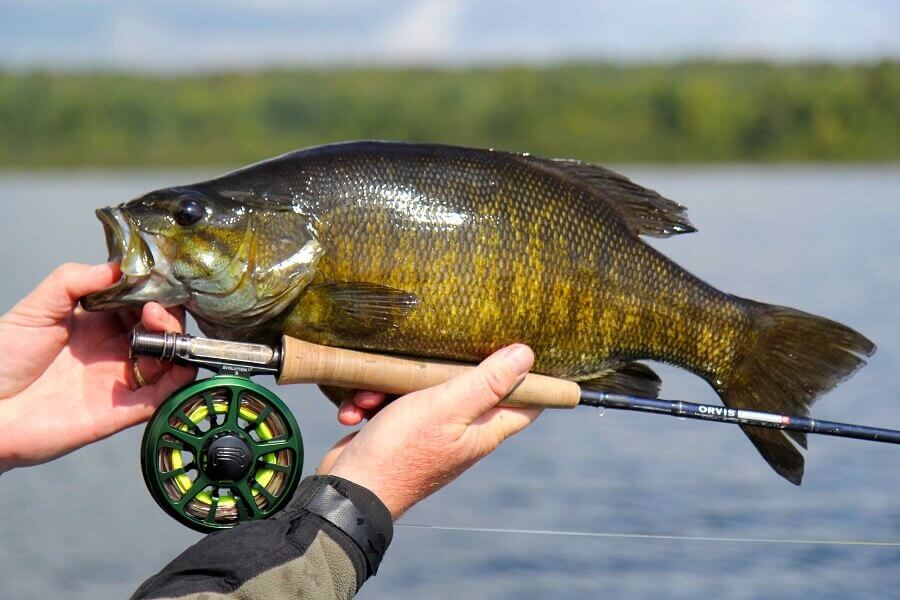
When it comes to bass fishing, selecting the right fishing rod is crucial for optimal performance and enjoyment.
Here are some key factors to consider when choosing a bass fishing rod:
- Rod Length: Bass fishing rods typically range in length from 6 to 7.6 feet (1.8 to 2.3 meters). Shorter rods offer better accuracy and control for precise casts, while longer rods provide greater casting distance and leverage when fighting larger fish.
- Power and Action: Power refers to the rod’s strength, while action refers to how much the rod bends when pressure is applied. For bass fishing, medium to medium-heavy power rods with fast or extra-fast action are commonly used. This combination allows for good sensitivity, casting distance, and ample power to handle bass.
- Material and Construction: Bass fishing rods are commonly made from graphite or fiberglass, or a combination of both. Graphite rods are lightweight, sensitive, and offer faster action, while fiberglass rods provide more durability and flexibility. Some rods combine both materials for a balance of strength and sensitivity.
- Rod Handle: The handle, also known as the grip, should be comfortable and provide a secure grip for casting and fighting fish. Common handle materials include cork, EVA foam, or a combination of both. The handle length and shape should suit your personal preference and fishing technique.
- Reel Seat: The reel seat is where the fishing reel attaches to the rod. Ensure that the reel seat is sturdy, well-constructed, and properly fits the size and type of reel you plan to use.
- Line Weight and Lure Weight: Consider the recommended line weight and lure weight specifications provided by the rod manufacturer. This ensures that the rod is suitable for the fishing line and lures you intend to use.
- Technique-Specific Rods: Some rods are specifically designed for certain bass fishing techniques, such as flipping, pitching, topwater, or finesse fishing. These rods often have specialized features to optimize performance in their respective fishing techniques.
It’s important to test and handle different rods before making a final decision to ensure the rod feels comfortable and balanced in your hands. Consider your fishing style, target bass species, and fishing conditions to select a rod that best suits your needs.
Here are some examples of fishing rods for bass fishing, along with their models and specifications:
- Casting Rod:
- Model: St. Croix Mojo Bass Casting Rod
- Length: 7 feet
- Power: Medium-Heavy
- Action: Fast
- Line Weight: 12-20 pounds
- Lure Weight: 3/8 – 1 1/4 ounces
- Spinning Rod:
- Model: G. Loomis E6X Spinning Rod
- Length: 6 feet 6 inches
- Power: Medium
- Action: Extra-Fast
- Line Weight: 6-12 pounds
- Lure Weight: 1/8 – 3/8 ounces
- Flipping/Pitching Rod:
- Model: Dobyns Champion XP Flippin’ Rod
- Length: 7 feet 6 inches
- Power: Heavy
- Action: Fast
- Line Weight: 14-30 pounds
- Lure Weight: 1/2 – 2 ounces
- Topwater Rod:
- Model: Abu Garcia Veritas Casting Rod
- Length: 7 feet 3 inches
- Power: Medium-Heavy
- Action: Moderate-Fast
- Line Weight: 12-20 pounds
- Lure Weight: 3/8 – 1 1/2 ounces
- Finesse Rod:
- Model: Daiwa Tatula Elite Spinning Rod
- Length: 7 feet 1 inch
- Power: Medium-Light
- Action: Extra-Fast
- Line Weight: 6-12 pounds
- Lure Weight: 1/8 – 3/8 ounces
Please note that the models and specifications provided are just examples, and there are many other brands, models, and variations available in the market. It’s important to consider your personal preference, fishing style, and budget when selecting a bass fishing rod. Additionally, make sure to choose a rod that is appropriate for the specific bass fishing techniques and conditions you plan to fish in.
Dishes
Bass is a popular fish for culinary purposes, and there are numerous delicious dishes you can prepare using bass as the main ingredient.
Here are a few examples:
- Grilled Bass: Season the bass with salt, pepper, and your choice of herbs or spices. Grill the fish over medium heat until it is cooked through and has a nice char on the outside. Serve with a side of roasted vegetables or a fresh salad.
- Baked Bass with Lemon and Herbs: Place bass fillets in a baking dish and season them with salt, pepper, lemon juice, and a mixture of herbs like thyme, rosemary, and parsley. Bake in a preheated oven until the fish is tender and flakes easily with a fork. Serve with steamed rice or quinoa.
- Pan-Fried Bass: Coat bass fillets in a mixture of flour, salt, and pepper. Heat oil in a skillet over medium-high heat and cook the fish until it is golden brown and crispy on both sides. Serve with a squeeze of lemon juice and a side of mashed potatoes or a green salad.
- Bass Tacos: Season bass fillets with a combination of chili powder, cumin, garlic powder, and salt. Sauté the fillets in a skillet until cooked through. Serve the fish in warm tortillas with your choice of toppings such as shredded cabbage, salsa, avocado slices, and lime crema.
- Bass Chowder: Prepare a creamy chowder by sautéing onions, celery, and garlic in butter until softened. Add diced potatoes, chicken or vegetable broth, and simmer until the potatoes are cooked. Add chunks of bass fillets and cook until the fish is opaque and flakes easily. Stir in cream or milk, and season with salt, pepper, and fresh herbs like dill or parsley.
These are just a few ideas to get you started, but there are countless ways to prepare and enjoy bass in various dishes. Feel free to experiment with different flavors, cooking techniques, and ingredients to create your own unique bass recipes.

